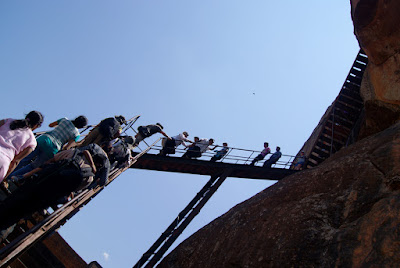The ruins of Sigirya,
claimed by locals to be the remains of an ancient palace but archeologically
verified as a former Buddhist monastery, are almost assuredly the highest of
all Sri Lanka’s ancient cities. The climb to the top involves over one thousand
stairs.
At the ground level, there is a moat, as well as various
supposed terraces, gardens and ponds, most of which amount to little more than
shallow remnants of brick walls. Among outcroppings of trees at the mesa’s
base, we began the laborious ascent. Brick stairs gave way to steps carved
directly into the stone as we rose steadily (or in my case, sweating and taking
frequent breaks) above the land.
A spiral stairwell, nearly rusted-through in places and shuddering
in the strong winds, led us to Sigirya’s famous frescoes (read: a cave full of
paintings of topless ladies). And another series of stone steps dumped us onto
a high plateau on the left side of the mesa and an incredible view across the
Lankan countryside.
Since it was still morning, we had spent the entire climb
shaded by the gargantuan mesa. Before us, yet more stairs, framed by an
enormous pair of stone lion paws, gave way to even more rickety iron stairs,
all of which had to be climbed in the blazing sun before we reached the top.
If I haven’t said it before, let me state now, for the
record, I hate climbing stairs. Give me a difficult hike and I’ll tough it out,
but the repetitive nature of climbing endless steps is abysmal, daunting, and
just flat-out, the worst. And to top
it all off, there were signs everywhere warning that loud noise would awake
swarms of wasps, and several families had screaming children.
I reached the top, sweaty, thirsty, and terrified of a wasp attack,
but triumphant. The ruins themselves amounted to little more than tiered
squares of foot-high brick walls, but the view was stunning and the breeze
refreshing.


























